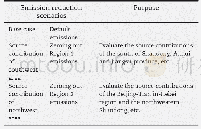《Table 5 XPS characteristics of Cu 2 p 3/2 region for the catalysts》
 提示:宽带有限、当前游客访问压缩模式
提示:宽带有限、当前游客访问压缩模式
本系列图表出处文件名:随高清版一同展现
《Preparation of CeO_2-Modified Mg(Al)O-Supported Pt–Cu Alloy Catalysts Derived from Hydrotalcite-Like Precursors and Their Catalytic Behavior for Direct Dehydrogenation of Propane》
a Numbers in parentheses are the FWHM of the fi tted peaks in eVb Intensity of the peaks as a percentage of the total Cu 2 p 3/2 area
The co-introduction of Pt and Cu signifi cantly enhanced the PDH performance,as the interaction between Pt and Cu accounted for the high catalytic activity of PDH[10].The initial propane conversion of PtCu/MgAl-R is higher than that of imp-PtCu/MgAl-R and slightly lower than that of PtCu/Ce 0.3 MgAl-R.After spending 360 min in the gas stream,the conversion of PtCu/MgAl-R,PtCu/Ce 0.3 MgAlR and imp-PtCu/MgAl-R decreased from 60,62,and 49to 44,45,and 31%,respectively.The slightly higher activity of PtCu/Ce 0.3 MgAl-R than that of PtCu/MgAl-R can be attributed to the high dispersion of Pt–Cu alloy and Cu NPs promoted by Ce,which is supported by the results of CO chemisorption in Table 4.The corresponding low activity of imp-PtCu/MgAl-R is related to the poor Cu dispersion and lack of interaction between Pt and Cu.The basic reason is the diff erent structural features between the PtCu/Ce 0.3 MgAl-R and PtCu/MgAl-R obtained by one-pot synthesis from HT precursor and imp-PtCu/MgAl-R prepared by impregnation.
| 图表编号 | XD0076873000 严禁用于非法目的 |
|---|---|
| 绘制时间 | 2019.04.01 |
| 作者 | Yingxia Li、Jiaxin Li、Xiao Yang、Xitao Wang、Yanhong Xu、Lihong Zhang |
| 绘制单位 | School of Chemical Engineering and Technology, Tianjin University、Tianjin Key Laboratory of Applied Catalysis Science and Technology, Tianjin University、School of Chemical Engineering and Technology, Tianjin University、Tianjin Key Laboratory of Applied Ca |
| 更多格式 | 高清、无水印(增值服务) |
查看“Table 5 XPS characteristics of Cu 2 p 3/2 region for the catalysts”的人还看了
-

- Table 1 Metadata summary of the“Dataset of strategical transformation regionalization for the agricul-tural comprehensiv
![Table 2 Scheme of the strategy transformation regionalization for Ningxia ACD[16]](http://bookimg.mtoou.info/tubiao/gif/QQSJ201902008_06100.gif)




